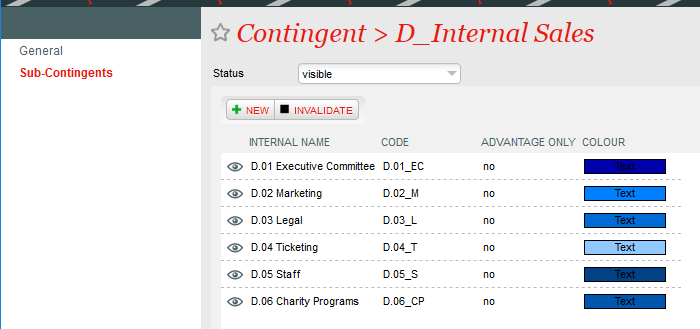...
Such a process has advantages in terms of flexibility, but consequently requires a more complex handling of seat quotas, which must be determined twice, once at an abstract level independently of the seat map, and once on the seat map itself. There is an additional effort to be planned to ensure the consistency of these quotas, and a careful decision should be made before making use of the functionalities described below.
1. Contingents
2. Logical configurations
3. Performance / match setup
4. Sales
5. Seating
6. Access control
Setup
| Anchor | ||||
|---|---|---|---|---|
|
To implement such a process, the first step is to create, in Institution | Initialisation | Contingents, a contingent of type = “Target group”, as below. A “Target group” is the top of a hierarchy of smaller “Sub-target groups”, which will be associated later with sales quotas for every match.
...
Once the “Target group“ is created, a set of sub-contingents, also known as sub-target groups, should be created inside the target group. The sub-contingents created should cover all possible use cases, even if there won’t be any quotas for them on some events.
| Anchor | ||||
|---|---|---|---|---|
|
On a logical configuration, it is then possible to define planned quotas for a selection of target groups and sub-target groups. There are two levels of quotas, both at target group and at sub-target group levels.
...
If planned quotas are defined, the system will prevent sales from going above the planned quota, which becomes a hard limit for sales inside a sub-target group and category, independently of the number of seats assigned on the map. Therefore, if additional seats on the map are added to a contingent, the planned quotas should also be raised.
| Anchor | ||||
|---|---|---|---|---|
|
When a performance or a match is validated, similarly to the handling of seat maps, the planned quotas defined in the logical configuration are duplicated into new values that are associated with the specific performance or match, and are then administered at the performance or match level, instead of within the logical configuration.
...
If necessary, it is possible to copy again the planned quotas from the logical configuration to the performance / match, in the Organisation | Catalogue | Performance / Match screen, using the “Change Planned quotas” screen. Is it also possible to copy only the quotas from one target group.
Operation
| Anchor | ||||
|---|---|---|---|---|
|
When using planned quotas, both front-office and back-office sales can be conducted without assigning any seats to the reservations or the sales.
...
Unseated files can be processed in the back-office like normal ones, in order to make exchanges, cancellations, payment of reservations, or cancellation of reservations.
| Anchor | ||||
|---|---|---|---|---|
|
A dedicated module is provided in the sales context to perform all seating operations. The screen Sales | Seating | Ticketing is the main way to assign seats to unseated files.
...
Once seats have been attributed to a file, they become visible on the front-office portals for customers, in the file details and in the list of tickets.
| Anchor | ||||
|---|---|---|---|---|
|
Unseated files already have tickets associated to them, and barcodes are already attributed, even though the seating is not yet defined. Therefore, such tickets should generally not be exported to any access control system, until the seating is finished.
...
